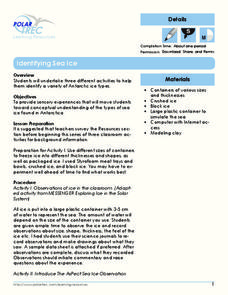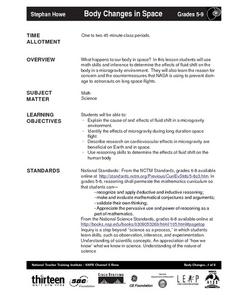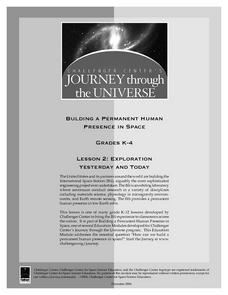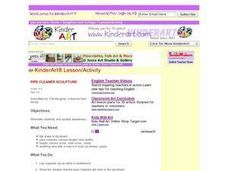English Worksheets Land
Out to Lunch
Enhance instruction and practice reading with a worksheet that doesn't just ask scholars to identify a sentence's point of view, but also poses the question, How do you know?
NOAA
Exploring Potential Human Impacts
Arctic sea ice reflects 80 percent of sunlight, striking it back into space; with sea ice melting, the world's oceans become warmer, which furthers global warming. These activities explore how humans are impacting ecosystems around the...
Polar Trec
Identifying Sea Ice
Sea ice contains 17 sub-types based on age and various characteristics. Scholars observe ice floating in a simulated ocean and record their observations. Then, they view photographs of different types of sea ice and learn to...
Curated OER
Lives of Stars
Young scholars explain in their own words how stars are formed. In this space science lesson, students summarize the life cycle of stars. They draw diagrams and label the step of the cycle they represent.
Curated OER
Winer Survival
Students study how animals need water, food, shelter, and space to survive. They also study what animals need to survive in the winter. They play the part of animals and winter "threats" in a game of tag to reinforce concepts.
Curated OER
Fine Motor Skills
Fourth graders discuss what they know about the planets, space, and the solar system including the colors of the planets. They also talk about why the planets are the color that they are. Next, they color cut-outs of the planets using...
Curated OER
Constellations
Third graders investigate space by researching their zodiac signs. For this space science lesson, 3rd graders discuss the different zodiac symbols, their star representation and where the stars are located in the sky....
Curated OER
Gross Motor Development
Fourth graders participate in a game reflecting the solar system, stars, and rockets. They simulate how space invaders move and hit stars and rockets. They discuss how scientists study the stars and planets.
Curated OER
Body Changes in Space
Students explain the cause of and effects of fluid shift in a microgravity
environment. Students identify the effects of microgravity during long duration space flight. Students describe research on cardiovascular effects in microgravity...
Curated OER
Exploration Yesterday and Today
Students compare and contrast the voyages of early explorers with the space explorations of the present day. After reading the biographies of Benjamin Banneker and Timothy Livengood, students create a Venn Diagram comparing and...
Curated OER
Building a School Model: An Academic Challenge
First and second graders explore aspects of design. They discuss and design the ideal classroom building complete with window and door placement. Additionally, students observe and note features found in neighboring classrooms as...
Education.com
Daily Planner
Helpful for learners of all ages, a daily planner template is a great way for kids to keep their work organized. It includes spaces for five subjects, as well as spaces for upcoming work and notes.
Student Handouts
A Society in Transition
Cover the 1980s in your class with a brief informational text and seven related questions. The one-page reading passage includes general information about jobs and skills, population patterns, and the AIDS epidemic.
Curated OER
Let's Go Exploring!
Use a Courbet painting of a cave or tunnel opening to reinforce the importance of descriptive writing. Writers of all ages use sensory details to describe what the scene depicts as they pretend to be in the painting. Then they imagine...
Curated OER
Emergency Contacts
Use an easy-to-read emergency contact list for kids of all ages. With a space for Mom's number, Dad's number, and an additional contact, the list is a good resource for your emergency file.
College Board
2017 AP® English Language and Composition Free-Response Questions
In the age of the Internet, are libraries still important? A collection of sources, part of a set of sample free-response questions from the AP® English Language and Composition exam, discuss that question. A variety of sources,...
Curated OER
Graph Paper Patterns
Young artists divide a piece of graph paper into sections using rectangles, squares, and triangles. They then fill each section with patterns of shape and color. Elementary graders describe how their patterns are organized. Secondary...
Curated OER
Scattered Square Dance
Take a good, square look at this introductory square dancing lesson. Each square dance move has what is termed a "call." Teach some beginning calls to your young dancers. They can be scattered around so that their focus is on learning...
BioEd Online
Gravity and Buoyancy
Would a baggie filled with water have the same shape sitting on a table as it would in a bucket of water? Why not? Allow learners to find out first-hand the effects of gravity acting alone on the baggie, as well as when gravity is...
Curated OER
Social Studies: Area and Population Density
Math scholars of many ages examine the concept of population density and then discuss the significance of the population densities of Minnesota and China. They figure the population density of their school.
Curated OER
Pipe Cleaner Sculpture
Learners of any age can make the most out of their pipe cleaners. This art project idea is very simple and yet, it could result in some amazing works of art. They use pipe cleaners, flat styrofoam, straws, pasta, and beads to create...
Curated OER
Sponge Painting
Sponge painting is a technique that is fun for learners of all ages and it can be adapted to fit a variety of skill levels and subjects. Here, little ones use sponges and paint to make geometric patterns. Tip: Sponges can be cut into...
Curated OER
English Clubs and Corners
Teachers consider ways to display assignments and engage pupils in clubs. They study how to dedicate classroom space to motivate and inspire learners, as well as to enable them to work as a group in a non-threatening environment. They...
Shmoop
ELA.CCSS.ELA-Literacy.SL.11-12.5
If you allow the space for your class members to be creative with technology as they make a presentation, they will make you proud with their inventiveness. The resource suggests an open research project for which pupils look up...























